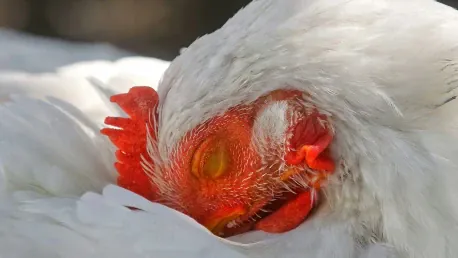The National Farmers’ Union (NFU) has recently called for enhanced biosecurity measures among farmers after detecting a case of avian influenza (H5N1) in a sheep in Yorkshire. This discovery came to light following routine surveillance, wherein avian influenza had previously been confirmed in captive birds on the same premises. National Farmers’ Union President Tom Bradshaw emphasized the need for vigilance among all keepers of domesticated poultry, cattle, sheep, and goats. Although this incident involves just one sheep, the concerns are considerable due to the potential implications for the broader livestock population. The detection in a different species raises questions and concerns about the virus’s behavior and its broader impact on livestock. The farming community is on high alert, ensuring that no stone is left unturned in protecting the livestock industry from this virulent pathogen.
Biosecurity Measures and Vigilance
The Department for Environment, Food & Rural Affairs (Defra) confirmed the presence of avian-origin influenza in the infected sheep based on multiple positive milk tests. This detection is particularly significant as the infected sheep was part of a backyard flock, yet no other cases were reported among the remaining sheep. The affected sheep was humanely culled to facilitate extensive testing by the Animal and Plant Health Agency at its Weybridge laboratory. Subsequent tests found no further avian influenza infections in the remaining flock, suggesting this may be an isolated case. To prevent similar incidents, farmers and keepers are urged to implement rigorous biosecurity practices. Bradshaw reassured stakeholders that commercial producers are continuing to uphold high biosecurity standards to safeguard their livestock. While the overall risk to the nation’s livestock remains low, maintaining these stringent practices is crucial to preventing potential outbreaks.
Farmers and keepers are advised to monitor their animals closely for any signs of disease and report any suspected cases of avian influenza immediately to the relevant authorities in England, Wales, or Scotland. In addition to monitoring domestic livestock, any dead waterfowl or wild birds must be reported to Defra for testing purposes. This proactive step allows for the early detection and management of potential cases before they can affect a larger population. The community’s cooperative effort in adhering to these protocols can significantly mitigate the risk of widespread infection, ensuring the health and well-being of the livestock.
The Importance of Surveillance and Response
The case in Yorkshire underscores the vital importance of biosecurity in preventing the spread of infectious diseases among livestock. This incident illustrates the balance between immediate response measures, such as culling and extensive testing, and proactive surveillance to mitigate potential outbreaks. Detailed testing by the Animal and Plant Health Agency indicates that while this was an isolated case, relentless vigilance remains crucial. Farmers must remain alert, employ stringent biosecurity methods, and collaborate with authorities for effective disease management. The cohesive response to the Yorkshire case serves as a potent reminder of the interconnectedness of animal health management practices across different livestock categories. Maintaining high standards of biosecurity, swift reporting of dead or ill birds, and comprehensive surveillance are integral to managing infectious diseases.
The incident in Yorkshire also highlights the adaptable nature of viruses and the potential risks posed to multiple species within the livestock sector. The need for robust biosecurity practices cannot be overstated, considering the broader implications for food security and animal welfare. This case serves as a call to action for all livestock keepers to re-evaluate and enhance their biosecurity protocols to protect against similar threats in the future. Enhanced biosecurity not only protects against avian influenza but also shields livestock from other potential infectious diseases that may arise.
Conclusion
The Department for Environment, Food & Rural Affairs (Defra) confirmed the presence of avian-origin influenza in a sheep after multiple positive milk tests. This finding is notable since the sheep was part of a backyard flock, with no other cases reported among the rest. The affected sheep was humanely culled for thorough testing by the Animal and Plant Health Agency at its Weybridge lab. Further tests revealed no additional avian influenza infections in the remaining flock, indicating this may be an isolated incident. To prevent similar cases, farmers and keepers are urged to enforce strict biosecurity measures. Bradshaw reassured stakeholders that commercial producers are maintaining high biosecurity standards to protect their livestock. Though the overall risk to national livestock is low, these stringent practices are vital to preventing potential outbreaks.
Farmers and keepers should monitor their animals for disease signs and report any suspected avian influenza cases to authorities in England, Wales, or Scotland. Additionally, any dead waterfowl or wild birds must be reported to Defra for testing. This proactive measure ensures early detection and management of potential cases, mitigating the risk of widespread infection and ensuring livestock health.









